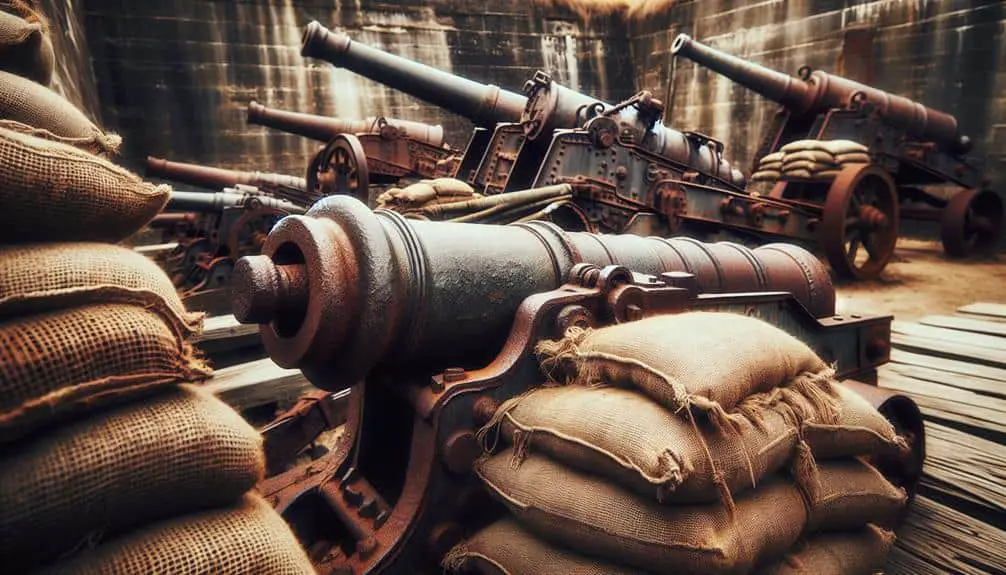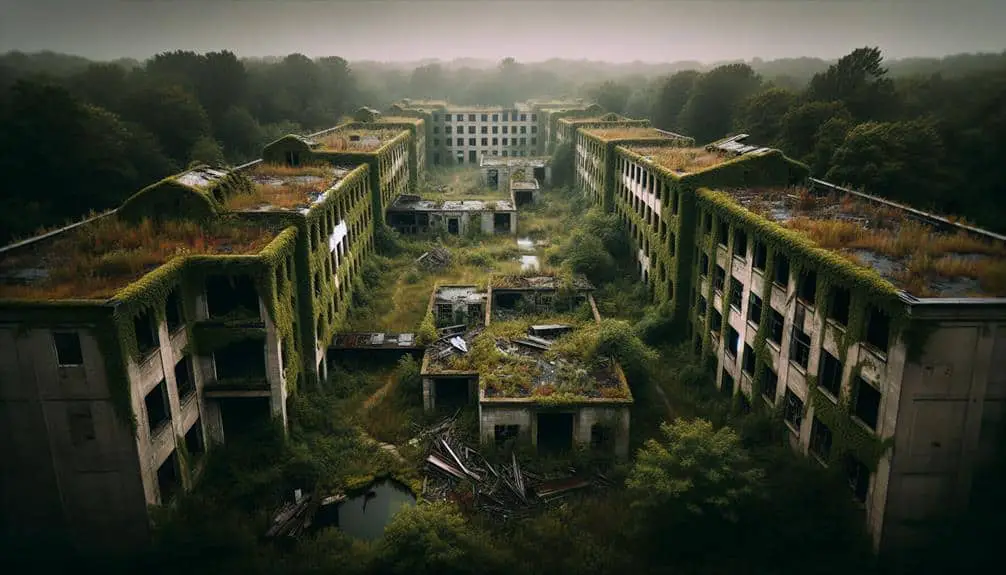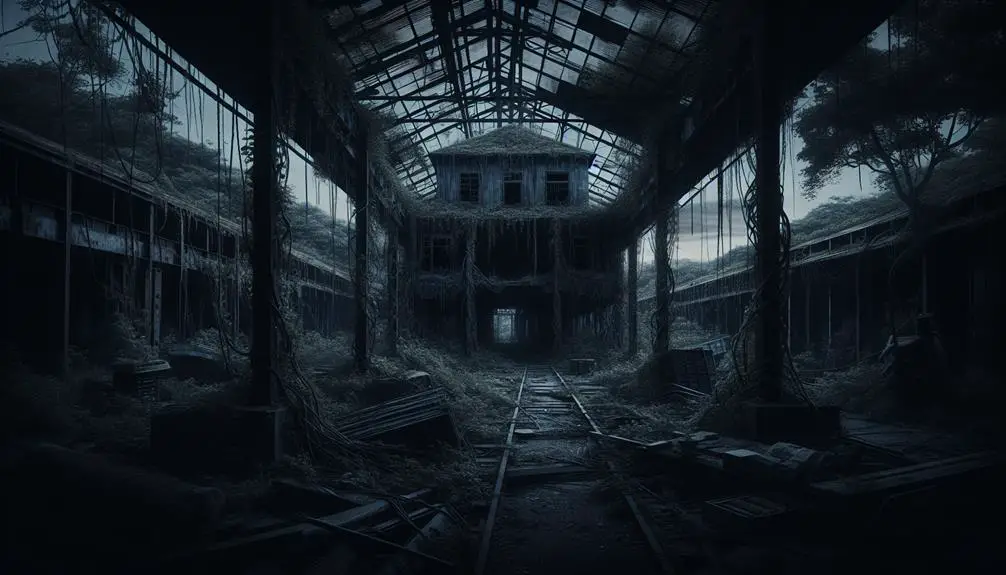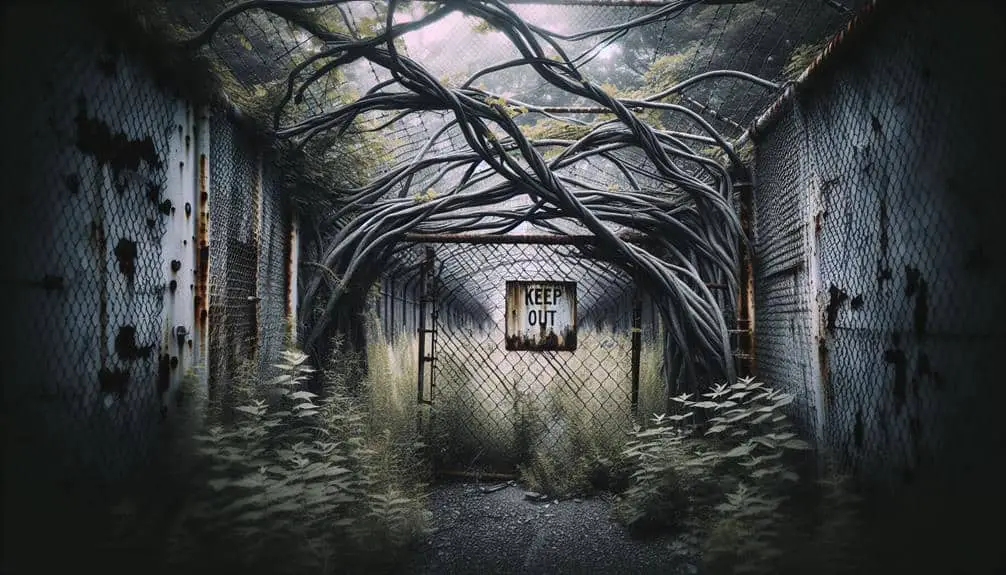Discover Fort Jefferson in Florida with its historic blend of architecture and natural beauty. Witness the pivotal role of Fort Sumter in South Carolina during the Civil War. Explore the strategic design of Fort Point in California with its gun emplacements. Visit Fort Macon in North Carolina for a glimpse into 19th-century coastal defense strategies. Learn about Fort Monroe in Virginia and its significant historical importance. Immerse yourself in the history of Fort Pickens in Florida, rich in military heritage. Plunge into the Civil War history at Fort Delaware in Delaware. Explore the innovative design of Fort Pulaski in Georgia and the secure gold vaults of Fort Knox in Kentucky.
Key Points
- Fort Jefferson in Florida offers a blend of history and natural beauty within a massive fortification.
- Fort Sumter in South Carolina played a pivotal role in the Civil War and showcases military engineering.
- Fort Point in California demonstrates the strategic importance of coastal defense with gun emplacements.
- Fort Macon in North Carolina offers well-preserved ramparts and barracks from the Civil War era.
- Fort Pickens in Florida, a key Union outpost during the Civil War, features sturdy brick walls and advanced artillery placements.
Fort Jefferson, Florida
Nestled within the crystal-clear waters of Dry Tortugas National Park lies Fort Jefferson, a remarkable military stronghold that stands as proof of the strategic importance of Florida's coastline. Built-in the 19th century, this imposing fortress offers a unique blend of history and natural beauty, making it a must-visit destination for history enthusiasts and nature lovers alike.
Exploration opportunities abound within the walls of Fort Jefferson. As you wander through the corridors and ramparts of this massive structure, you can't help but feel a sense of awe at the sheer scale of the fortification. From the towering walls to the expansive courtyard, every corner holds a story waiting to be discovered.
Wildlife encounters are also a common occurrence at Fort Jefferson. The surrounding waters teem with marine life, offering visitors the chance to spot colorful fish, playful dolphins, and even the occasional sea turtle. Birdwatchers will delight in the variety of avian species that call this area home, from majestic frigatebirds to graceful terns. Whether you're exploring the fort or simply soaking in the natural beauty of the park, Fort Jefferson promises a truly unforgettable experience.
Fort Sumter, South Carolina
Fort Sumter in South Carolina, a historic fortification, played a pivotal role in the start of the American Civil War. This stronghold, located in Charleston Harbor, witnessed the opening shots of the conflict on April 12, 1861, marking a significant turning point in American history. The Civil War, a defining moment in the nation's quest for unity and freedom, saw Fort Sumter as a key battleground where opposing ideologies clashed.
Fort Sumter's strategic location and innovative fortification techniques made it a formidable stronghold during the war. The fort's design, featuring sturdy brick walls and advanced artillery positions, showcased the military engineering of the time. These fortification techniques were essential in defending against enemy attacks and maintaining control over essential waterways.
Today, Fort Sumter stands as a symbol of resilience and the enduring legacy of the Civil War. Visitors can explore the fort's grounds, learn about its historical significance, and gain insights into the challenges faced by soldiers during this turbulent period in American history. Fort Sumter's preservation offers a glimpse into the past, preserving the memory of those who fought for their beliefs during a time of great upheaval.
Fort Point, California
Positioned at the entrance of San Francisco Bay, Fort Point in California stands as a demonstration of the strategic importance of coastal defense during the mid-19th century. Built between 1853 and 1861, this brick fortress played an essential role in protecting the bay from potential naval threats. Its location provided a commanding view of the Pacific Ocean, allowing defenders to monitor and safeguard the important waterways and ports of San Francisco.
Fort Point holds a significant place in military history as it represents a time when coastal defenses were paramount for national security. The fort's design, featuring formidable casemates and gun emplacements, reflects the military strategies of the era aimed at deterring enemy incursions and safeguarding significant harbors.
Today, visitors can explore the corridors and chambers of Fort Point, gaining insights into the challenges and innovations of coastal defense in the 19th century. The well-preserved structure offers a window into the past, allowing you to appreciate the dedication and ingenuity of those who served to protect the nation's shores.
Fort Macon, North Carolina
Demonstrating resilience and historical significance, Fort Macon in North Carolina stands as proof of the strategic foresight and military prowess of its era. Built between 1826 and 1834, this coastal defense fortification played an essential role during the Civil War, protecting Beaufort Harbor.
The fort's strategic location allowed it to guard the entrance to the harbor, a critical point for the Confederate forces. Its solid brick walls and advanced construction made it a formidable stronghold. The fort saw action in 1862 when it fell to Union forces after enduring a lengthy siege.
Today, visitors to Fort Macon can explore the well-preserved ramparts, barracks, and artillery rooms, providing a vivid glimpse into the past. The fort's museum displays artifacts and exhibits detailing its role in coastal defense and the Civil War.
As you wander through the corridors of Fort Macon, you can almost sense the echoes of the soldiers who once manned its defenses, standing strong in the face of adversity and protecting the freedom of their land.
Fort Monroe, Virginia
When examining Fort Monroe in Virginia, it's essential to contemplate its profound historical significance within the context of American military history.
Preservation efforts at Fort Monroe have been meticulous and extensive, aiming to conserve its rich heritage for future generations.
Understanding the historical importance and ongoing preservation initiatives at Fort Monroe provides valuable insights into the nation's military past and efforts to uphold its legacy.
Historical Significance of Fort Monroe
With a rich history dating back to the early 19th century, Fort Monroe in Virginia stands as a prominent symbol of strategic military planning and defense. During the Civil War, the fort played a pivotal role in military strategy as a Union stronghold. Its position on the Chesapeake Bay provided a strategic advantage, allowing for the protection of the nearby capital, Washington D.C.
Fort Monroe's most significant historical moment came in 1861 when it became a safe haven for escaped slaves seeking refuge. Additionally, it was at Fort Monroe that Confederate President Jefferson Davis was imprisoned following his surrender. The fort's historical significance lies not only in its military importance but also in its role in shaping the course of freedom and justice in America.
Preservation Efforts at Fort Monroe
Preservation efforts at Fort Monroe in Virginia focus on safeguarding its historical buildings and artifacts for future generations to explore and learn from. When it comes to preserving this significant military base, the following aspects are vital:
- Conservation Techniques: Implementing cutting-edge methods to protect structures and items.
- Community Involvement: Engaging locals in the preservation process fosters a sense of ownership.
- Tourism Potential: Showcasing the preserved base attracts visitors and boosts the local economy.
- Educational Programs: Offering learning opportunities to understand the base's historical importance.
- Continuous Maintenance: Ensuring regular upkeep to prevent deterioration and maintain authenticity.
Fort Moultrie, South Carolina
When exploring Fort Moultrie in South Carolina, you'll encounter a site rich in historical significance. Boasting a variety of architectural features that tell a story of its military past. Preservation efforts at Fort Moultrie have been meticulous, ensuring that visitors can witness firsthand the legacy of this important military base.
The blend of history, architecture, and preservation initiatives at Fort Moultrie makes it a must-visit destination for those interested in military history.
Historical Significance of Fort Moultrie
The historical significance of Fort Moultrie in South Carolina lies in its pivotal role during various conflicts throughout American history.
- Fort Moultrie's impact on Charleston was significant, as it served as an essential defense post guarding the city against naval attacks.
- The fort witnessed notable military technology advancements, showcasing the evolution of coastal defense strategies.
- It played a key role in the American Revolution, repelling British forces in a decisive battle that boosted patriot morale.
- During the Civil War, Fort Moultrie and its neighboring forts formed an important coastal defense network, influencing the course of the conflict.
- The fort continued to play a strategic role in the Spanish-American War, exemplifying its enduring importance in American military history.
Architectural Features of Fort
Amidst the coastal landscape of South Carolina, Fort Moultrie stands as proof of the architectural ingenuity of its time, blending functionality with strategic design elements.
The barracks design within the fort demonstrates a practical approach, providing shelter for soldiers while allowing for efficient movement during times of conflict.
The defensive structures, including bastions and ramparts, showcase the forethought put into safeguarding the fort against potential attacks.
Artillery placement at Fort Moultrie was strategically planned, with cannons positioned to cover key approaches and create overlapping fields of fire, maximizing defensive capabilities.
The layout of the fort itself was intricately designed to optimize defensive positions and enhance communication among soldiers.
Fort Moultrie's architectural features not only reflect the military tactics of the past but also offer a glimpse into the strategic mindset of the era.
Preservation Efforts at Fort
Preserving Fort Moultrie in South Carolina requires meticulous attention to historical details and strategic restoration efforts in order to maintain its architectural integrity and historical significance.
When it comes to the preservation efforts at Fort Moultrie, several key factors come into play:
- Preservation Techniques: Implementing advanced conservation methods to safeguard the fort's structures and artifacts.
- Historical Importance: Highlighting the significance of Fort Moultrie in shaping American history and its role in various military conflicts.
- Conservation Challenges: Overcoming obstacles such as weathering, aging infrastructure, and funding constraints.
- Visitor Engagement: Creating interactive exhibits and educational programs to involve visitors in the fort's history.
- Community Involvement: Encouraging local support and participation in preserving this crucial piece of national heritage.
Fort Pickens, Florida
Nestled along the coastline of the Gulf of Mexico in Florida lies Fort Pickens, a well-preserved military base rich in history and significance. Constructed in the 1830s, this coastal stronghold was part of a network of strategic coastal defenses. Fort Pickens played a vital role during the Civil War, serving as a key Union outpost and successfully fending off Confederate attacks.
The fort's design, characterized by sturdy brick walls and advanced artillery placements, showcases the military engineering of its time. The remnants of barracks, gun emplacements, and storage facilities offer a glimpse into the daily lives of soldiers stationed here. Walking through the fort today, you can almost feel the echoes of the past reverberating through its corridors.
Visitors to Fort Pickens can explore the various defensive structures, including the imposing bastions and casemates that once housed cannons ready for action. The site's preservation allows you to immerse yourself in the history of coastal defenses and the pivotal role Fort Pickens played in safeguarding the nation during times of conflict.
Fort Delaware, Delaware
Fort Delaware in Delaware stands as a significant historical landmark, embodying the enduring legacy of military fortifications in the United States. This fort, with its rich Civil War history, has been meticulously restored to preserve its authenticity and offer visitors a glimpse into the past.
When you explore Fort Delaware, you'll encounter:
- Civil War History: Immerse yourself in the stories and events that shaped the nation during this tumultuous time.
- Restoration Efforts: Witness the dedication to maintaining the fort's original features and ambiance through careful restoration work.
- Prisoner of War Artifacts: Discover artifacts and exhibits that shed light on the experiences of prisoners held within the fort's walls.
- Guided Tours: Engage in informative tours led by knowledgeable guides who bring the history of Fort Delaware to life.
- Historical Significance: Appreciate the importance of this site in understanding the challenges faced by soldiers and prisoners during the Civil War.
Fort Pulaski, Georgia
With its strategic location on Cockspur Island near Savannah, Georgia, Fort Pulaski played a significant role in the history of military fortifications in the United States. Built to protect coastal defenses, this formidable structure stands as one of the most well-preserved Civil War landmarks in the country.
Constructed between 1829 and 1847, Fort Pulaski's pentagonal-shaped walls and innovative design were ahead of its time. The fort's brick construction and advanced defensive features, including moats and drawbridges, showcase the military engineering expertise of the era.
During the Civil War, Fort Pulaski was the site of a pivotal battle in 1862. Union forces successfully tested rifled cannons, leading to the fort's surrender after just 30 hours of bombardment. This event marked a turning point in military history, demonstrating the vulnerability of traditional fortifications against modern artillery.
Today, visitors to Fort Pulaski can explore the extensive grounds, cannon emplacements, and the damage inflicted during the siege. The fort's preservation offers a glimpse into the past, allowing visitors to appreciate the significance of this historical site in shaping military strategies and coastal defenses.
Fort Knox, Kentucky
The military base relics at Fort Knox, Kentucky, showcase a rich history of strategic defense and gold storage. Established in 1918, Fort Knox has been an essential site for military training and safeguarding the nation's gold reserves. Here are some key features that make Fort Knox stand out:
- Impenetrable Gold Vaults: Fort Knox is renowned for its highly secure gold vaults, which are said to contain a significant portion of the United States' gold reserves.
- Historic Military Training Grounds: The base has served as a pivotal military training facility over the years, honing the skills of countless soldiers and preparing them for service.
- Iconic Patton Museum: Within Fort Knox lies the General George Patton Museum, dedicated to preserving the history of armored warfare and the legacy of General Patton himself.
- Strategic Location: Positioned in Kentucky, Fort Knox occupies a significant location that has played a pivotal role in military operations and national defense.
- Architectural Significance: The architecture of Fort Knox's buildings reflects the changing styles and needs of the military throughout its history, providing insight into past military practices and lifestyles.
Frequently Asked Questions
How Were These Military Bases Funded and Constructed During Their Time of Operation?
You funded and constructed military bases through government allocations and labor efforts. These bases, with historical significance, are preserved to honor their past. Understanding their funding and construction sheds light on their importance and legacy.
What Types of Military Units Were Stationed at These Bases and What Were Their Specific Roles?
Military units stationed at these bases had diverse roles like defense, training, and strategic operations. Their historical significance lies in shaping US military history and national defense strategies, contributing to the country's security and development.
Are There Any Reported Paranormal Activities or Hauntings at These Preserved Military Base Relics?
Have you ever wondered about paranormal activities at military base relics? These sites have sparked numerous ghost stories and attracted paranormal investigations. The eerie tales add a layer of mystery to the well-preserved historical locations.
Have Any Famous Historical Figures or Events Been Associated With These Military Bases?
Famous figures and notable events are intertwined with these military bases, adding layers of historical significance. From influential leaders to pivotal moments, these sites serve as living reminders of the impactful individuals and events that shaped our past.
How Have These Military Bases Been Maintained and Preserved Over the Years Since Their Decommissioning?
You've seen how these bases endure like a sentinel, standing tall against time's relentless march. Maintenance efforts are meticulous, preservation techniques precise. Each relic tells a story of dedication and honor.



